North Korea missile test: ICBM ‘success’ leads to Australia’s condemnation
NORTH Korean dictator Kim Jong-un reportedly laughed after sending the United States a deeply chilling Independence Day “gift”.
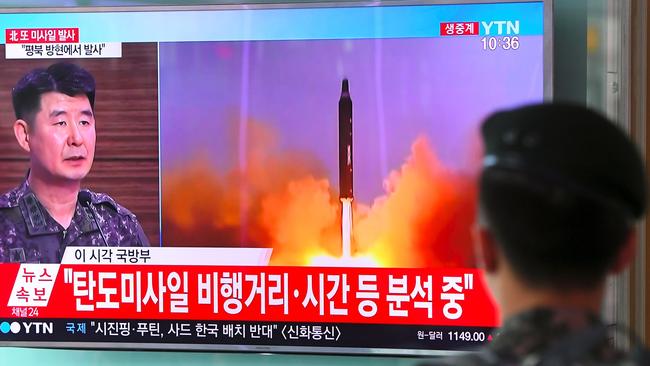
A DEFIANT North Korea said its latest intercontinental ballistic missile test was a “gift” to “American bastards” on their Independence Day.
According to the Korean Central News Agency Kim Jong-un said: “American bastards would be not very happy with this gift sent on the July 4 anniversary.”
Pyongyang’s official news agency also reported the North Korean leader laughed before adding “that we should send them gifts once in a while to help break their boredom”.
KCNA are renowned for spouting propaganda and are the major mouthpiece for the Kim regime.
The defiant comments come as the North made a major breakthrough in its first intercontinental ballistic missile test, in a move which has alarmed experts and sparked global condemnation.
Australia was quick to condemn the DPRK, with Foreign Minister Julie Bishop calling North Korea “provocative” for testing the missile amid speculation it is capable of delivering a nuclear weapon to Northern Australia and the US state of Alaska.
The brazen move comes months after US President Donald Trump tweeted North Korea wasn’t capable of developing a weapon that could hit parts of the US.
North Korea just stated that it is in the final stages of developing a nuclear weapon capable of reaching parts of the U.S. It won't happen!
— Donald J. Trump (@realDonaldTrump) January 2, 2017
The missile, believed to have been launched from Panghyon, 100km northwest of the North Korean capital Pyongyang, flew for almost 1000km over 40 minutes and landed in Japanese waters.
The test of the Hwasong-14 intercontinental ballistic missile under the supervision of North Korean leader Kim Jong-un comes ahead of Prime Minister Malcolm Turnbull leaving for Hamburg ahead of the start of the G20 summit.
David Wright, of the Union of Concerned Scientists, wrote on the organisation’s allthingsnuclear blog that the available figures implied the missile had “a maximum range of roughly 6700km on a standard trajectory”.
“That range would not be enough to reach the lower forty-eight states or the large islands of Hawaii, but would allow it to reach all of Alaska.”
That would also mean the Australian mainland is also potentially within reach of the missile.
Panghyon Airport is 5861km away from Darwin in the Northern Territory and 6678km from Cairns.
Alaska is about 5862km from the launch site.
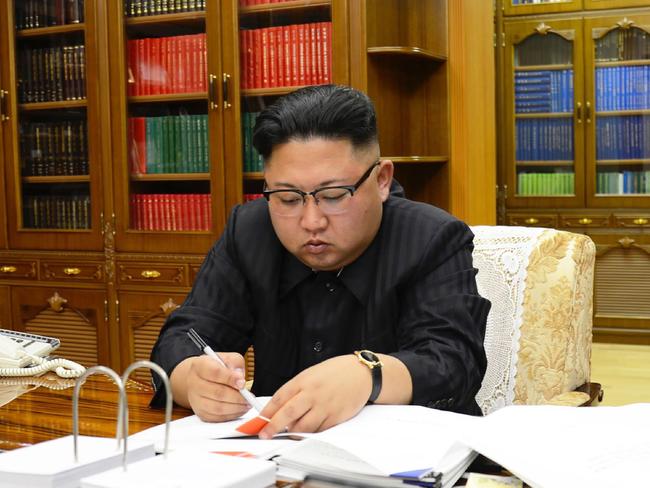
Ms Bishop said the “provocative ballistic tests” breached United Nations Security Council resolutions.
“North Korea continues to threaten its neighbours while undermining regional and global security,” Ms Bishop said in a statement.
“North Korea’s long-term interests would be best served by ceasing its nuclear and missiles programs and focusing on improving the lives of its long-suffering people.”
Speaking to AM’s Sabra Lane former Prime Minister Kevin Rudd said the test was very provocative.
The former Labor leader who is now the president of the Asia Society Policy Institute also warned the development was “a dangerous new phase”.
“On the scale of one to ten this is eight of ten provocative,” he said.
“First it’s been done on the Fourth of July, America’s national day, and second on a day when President Putin and Xi Jinping are meeting in Moscow in preparation for the G20.
“Thirdly, and most importantly, this is the first ICBM, intercontinental ballistic missile test, undertaken successfully by the North Koreans.”
He said this put Alaska in the reach of a missile which was “right up there in the league of provocative activity.”
However Acting US ambassador to Australia James Caruso questioned claims the missile was, in fact, intercontinental.
He also expressed concern that North Korea continues to violate UN resolutions and is launching missiles in the direction of other countries.
“The whole world has to come together to get them to stop and denuclearise the Korean peninsula,” he said.
Mr Caruso said Mr Trump has been warning North Korea by calling on other nations to stop trading with them and employing their workers.
“He wants to tell North Korea that if they’re going to be an outlaw among the international community by doing these nuclear tests and launching these missiles, there are consequences.”
The launch sparked an emergency Security Council meeting.
United States Ambassador to the United Nations Nikki Haley tweeted the US, Japan and South Korea pushed for the meeting.
The U.S., Japan & S.Korea have called for an open emergency meeting of the Security Council regarding N.Korea's ICBM launch. pic.twitter.com/VlCamPpWIq
— Nikki Haley (@nikkihaley) July 4, 2017
Spending my 4th in meetings all day. #ThanksNorthKorea
— Nikki Haley (@nikkihaley) July 4, 2017
‘GAME OF CHICKEN’
In an interview in April, New York-based Political analyst and Asian specialist Sean King said he believed the nuclear program was strategic and North Korea’s way of forcing the US into talks.
He also said he believed the likelihood of conflict was low because North Korea rattles its sabre a lot and World War 3 hasn’t happened yet.
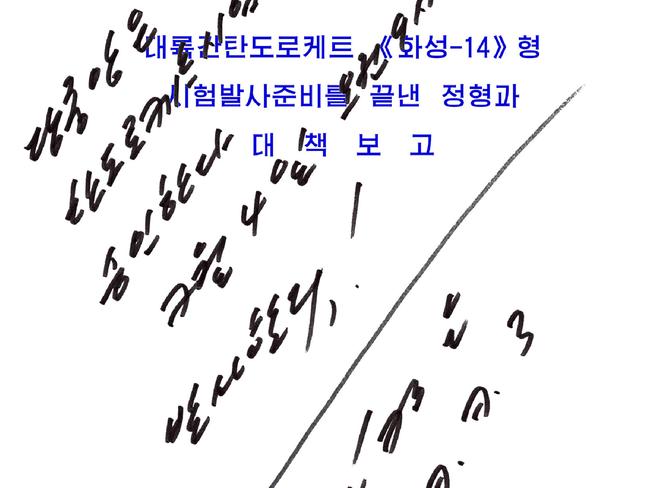
Mr King told ABS/CBN News the aggressive posturing was designed to preserve the North Korean government, which saw the nuclear program as a form of protection against external threats of regime change.
“It wants US troops out of the south and it feels by a holding a nuclear gun to our head it will force us into bilateral negotiations with Pyongyang,” he said.
Speaking to news.com.au from New York, Mr King said that despite the most recent test, he still believed the chance of conflict on the Korean Peninsula was still low.
“Today’s launch is serious business but we (US) shouldn’t overreact,” he said.
“North Korea isn’t ISIS, they want to live and enjoy the sins of the material world.”
Mr King said he didn’t believe Pyongyang actually wanted to use its nukes.
“Rather, it’s a game of chicken to force us into the negotiations,” he said.
“We can’t blink, not now.”
He said Mr Trump should instead keep sanctions going while continuing to target the flow of North Korean money which will bring the regime down.
“There’s no other way, as the regime and its missiles/nukes are a package deal,” he said.
“You can’t have one without the other; they’re now symbiotic. Hence despite US Secretary of State Tillerson’s not long ago olive branch of sorts to Pyongyang, ultimate regime change is in fact, the only way out of this.”
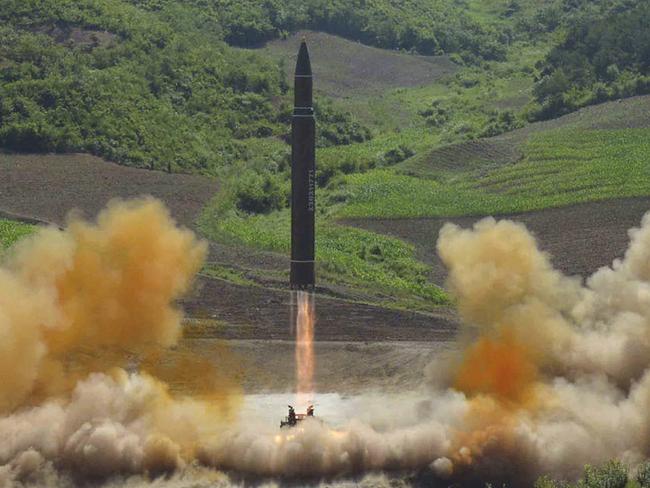
MILESTONE HIT
The North’s possession of a working ICBM represents a huge milestone for the communist regime.
It could also radically alter the calculus for countries seeking to thwart the military goals of the isolated state.
Some experts said the device could reach Alaska.
Others suggested it could go much further toward the US mainland though there was widespread scepticism of the North’s claim of the missile being able to “strike any place in the world”.
The Hwasong-14 missile test was overseen by Kim, an emotional female announcer said on state television, showing a handwritten order for the launch and pictures of the young leader grinning in celebration, clenching his fist.
The North’s Academy of Defence Science, which developed the missile, said it reached an altitude of 2802 kilometres.
There are still doubts whether the North can miniaturise a nuclear weapon to fit a missile nose cone, or if it has mastered the technology needed for it to survive re-entry into the Earth’s atmosphere.
Since Kim came to power there have been advances including three nuclear tests and multiple rocket launches.
But former commanding officer of the British Armed Forces Joint Chemical Biological Radiological Nuclear Regiment Hamish de Bretton-Gordon told CBS News the move was certainly a step forward.
“In capability of missile terms and delivery, it is a major step up and they seem to be making progress week-on-week,” he said.
But he said the regime still faced a hurdle.
“Actually marrying the warhead to the missile is probably the biggest challenge, which they appear not to have progressed on,” he said.
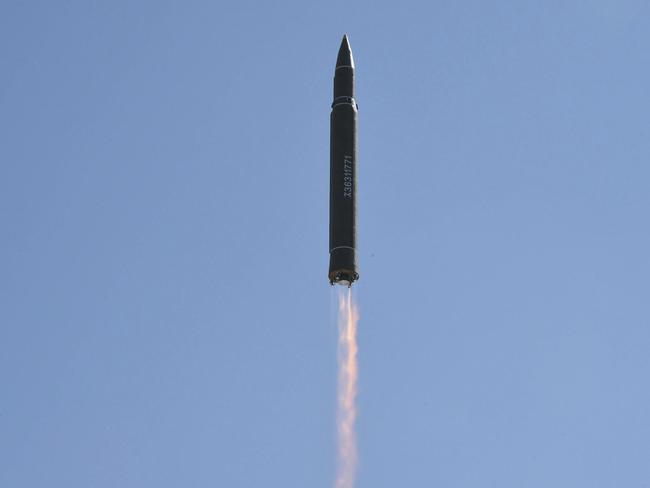
ELEMENT OF SURPRISE
According to Brendan Thomas-Noone, a research fellow in the Alliance 21 Program at the University of Sydney’s United States Studies Centre, the successful test demonstrated an upgraded capability from the North Koreans.
“US Secretary of State Rex Tillerson has confirmed that it was indeed an ICBM,” Mr Thomas-Noone said.
“It had a second stage that reportedly provided an extra 30 seconds of flight and a potential range greater than 5500km. The test is a successful demonstration of a limited ICBM capability.”
Mr Thomas-Noone said the demonstrated range of the new North Korean ICBM showed it could potentially strike Alaska and parts of Northern Australia.
He said the west has known for a while that North Korea was reaching for an ICBM and that this is one of their strategic goals.
But he said what surprised many was that the North was able to achieve this so quickly.
Mr Thomas-Noone said that while he believes war is still unlikely, there was a danger tensions could easily spiral out of control.
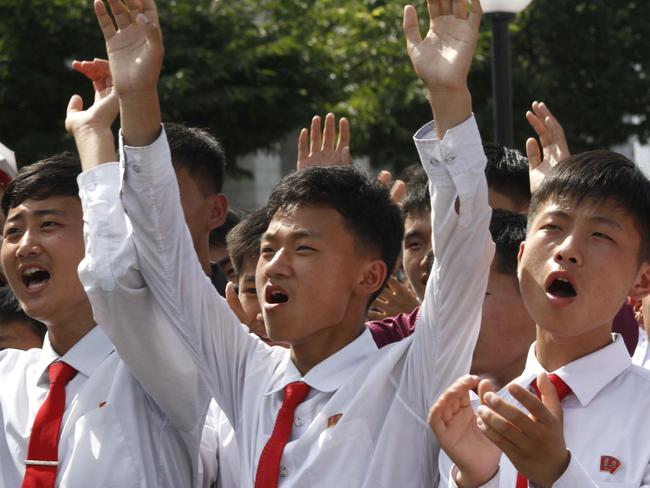
“All the same structural factors that have been in place preventing a conflict on the Korean Peninsula are still there,” he said.
“There are no acceptable military options when it comes to North Korea and that is still true now.”
He said a pressing concern was how governments will react.
“We should be worried when it comes to escalation and that is what must be controlled now by governments in the region, including Australia’s,” he said.
“Tit-for-tat exercises and military demonstrations can easily raise tension and can be misinterpreted, spiralling out of control. Caution is what is needed now, not aggressive posturing.”
‘THREAT GROWS’
US Pacific Command confirmed the test and said it was a land-based, intermediate range missile that flew for 37 minutes before splashing down in the Sea of Japan, adding the launch did not pose a threat to North America.
Moscow’s defence ministry called it medium-range. But Tokyo estimated the maximum altitude to have “greatly exceeded” 2500 kilometres, prompting arms control specialist Jeffrey Lewis to respond on Twitter: “That’s it. It’s an ICBM. An ICBM that can hit Anchorage not San Francisco, but still.”
Add this to the list of national security threats Sarah Palin can see from her house. https://t.co/RYmnQ2Aeqq
— Jeffrey Lewis (@ArmsControlWonk) July 4, 2017
Mr Lewis also tweeted the world has been in denial about North Korea’s ICBM system for years and the latest missile could have an even bigger range than first believed.
Worth pointing out that the demonstrated range of the Hwasong-14 (6700 km) may not be its maximum range. https://t.co/BN5CcZ0jnk
— Jeffrey Lewis (@ArmsControlWonk) July 4, 2017
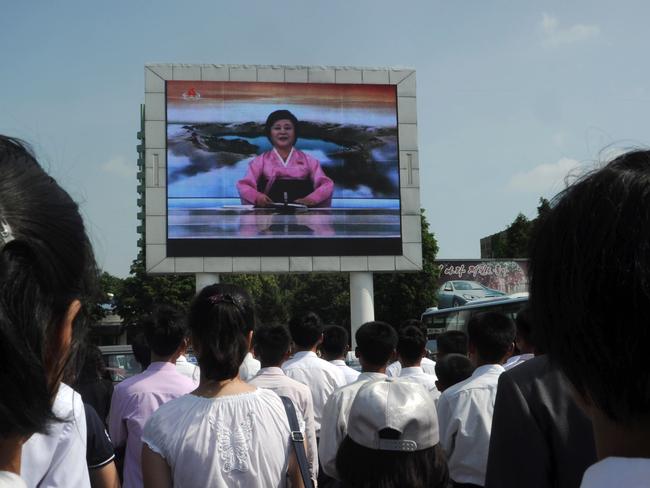
Antoine Bondaz, an analyst at the Foundation for Strategic Research in Paris, said the launch was a “humiliation” for Mr Trump after his repeated attempts to get China to rein in Pyongyang, adding that greater missile ranges were probably possible in future tests.
“If you change the initial angle of fire, you could reach a range of 6700km. Ballistics is like throwing a rock: the farther you want to go, the lower the angle of fire,” Mr Bondaz added.
Japanese Prime Minister Shinzo Abe said: “This launch clearly shows that the threat has grown.”
- with AFP/AAP



